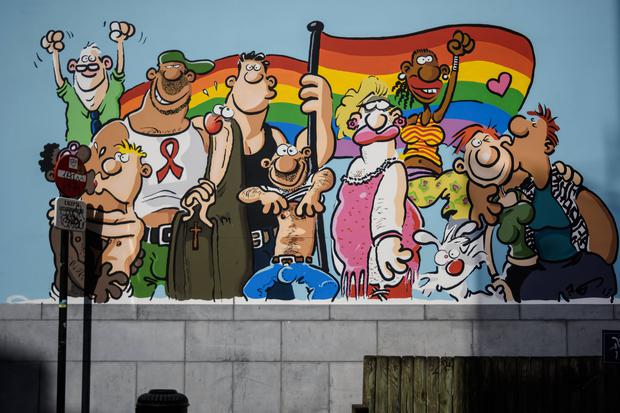Visitors only have to walk a few steps from the Gare du Midi, Brussels’ southern railway station, to be greeted in a friendly manner by two old acquaintances: the colored heads of the cartoon characters Tintin and Struppi, known here as Tintin et Milou, smile down from the roof of an elegant post-war office building.
The rotating advertising sign is a distinctive feature of the city. It was built in 1958 to decorate the headquarters of the Lombard publishing house, which published the comic magazine Tintin from 1946. Countless other characters debuted in it, including racing driver Michel Vaillant, detective Rick Master and western hero Comanche.

Brussels and the comics: it’s a love story. The “Bandes Dessinées”, as comics are called in French-speaking countries, have been an integral part of Belgian culture since Georges Remi aka Hergé laid the foundation for the local comic tradition in 1929 with the first adventure of Tintin.
From Lucky Luke to Gaston to Caroline Baldwin
Brussels in particular, often referred to as the comics capital of Europe, honors the art form and its creators with monuments, museums and murals across the city.

The comic frescoes that adorn numerous house walls, walls and metro stations are characteristic of Brussels. On the Grand Place, Brussels’ magnificent market square with its historic guild houses, you can buy a paperback (“be comic strip – Brussels, the comic capital”) in the town hall, which shows the thematic tour on a city map.
This makes it easy to locate the more than 80 comic frescoes. From Lucky Luke to Gaston to Caroline Baldwin, they mainly depict well-known Belgian comic characters, but Asterix and Corto Maltese are also among them.
Trompe-l’oeil effects and Ralf König
Near the Rue du Marché aux Charbons, a lively street full of cafés, there are particularly many, including the very first fresco from 1991, which shows Frank Pé’s cartoon character Jonas Valentin and his girlfriend Catherine happily strolling through Brussels.
Some motifs are so skilfully integrated into the facades that interesting trompe-l’oeil effects result. A contribution by a German artist can also be found in a side street: Ralf Königs Fresko is dedicated to the diversity of the LGBTQI* scene. Experimental works by young street artists can also be discovered on some facades.

Numerous galleries such as Galerie Champaka specialize in comics and offer changing exhibitions. Comic book stores can be found in every neighborhood. Two of Brussels’ best dealers are based on the central Boulevard Anspach: “Brüsel” also offers signed art prints, while “Multi BD” has a slightly larger range.
Comics and Art Nouveau
There are also numerous comic museums. The centrally located “Centre Belge de la Bande Dessinée” on Rue des Sables was opened in 1989 in a beautiful Art Nouveau building built in 1906. It features comic book exhibitions on three floors.
The history of the art form is conveyed concisely using many original drawings and its diversity is illustrated using different narrative forms and drawing techniques. Temporary exhibitions revolve around the Smurfs and their creator Peyo or the manga “Naruto”.

On the occasion of Marsupilamis’ 70th birthday, “The Houba Show” was dedicated until recently to the mythical animal invented by André Franquin. The exhibition, partly decorated like a jungle, is also attractive to children.

The Flemish comic artist Marc Sleen (1922-2016) is also honored. From 1947 to 2002, Sleen drew a total of 217 satirical albums about his character “Nero”, a Brussels petty bourgeois who met numerous statesmen of his time – from Stalin to Saddam Hussein. As a result, Sleen made it into the Guinness Book of Records in 1992 as the “most prolific draftsman in the world”.
Opposite is the small “Marc Sleen Museum”. In the “Congo Comics” exhibition, works by contemporary African artists are juxtaposed with controversial stereotypical depictions of Africans in Sleen’s work. Young Brussels comic creators are guests of the “Foundation Marc Sleen” and draw live between the exhibition areas.

This is where the Smurfs meet the Hulk: near the Central train station is the “Moof” figure museum. Private collectors have come together to display their extensive collections of (sometimes life-size) comic book figurines, which are displayed in showcases arranged by topic.
Unfamiliar sides of Hergé
Finally, outside of Brussels, in Louvain-La-Neuve, is the Hergé Museum. The building, which opened in 2009, impresses with its modern architecture and spacious exhibition areas. The life and work of the creator of Tintin and Struppi is presented on several floors.
Original comic pages and artifacts like Hergé’s drafting table allow visitors to understand how his masterpieces were created.

The early illustrations and advertising graphics from the 1930s are also worth seeing. Hergé’s interest in abstract painting, his contact with Andy Warhol and his attempts at painting in the 1960s reveal unusual aspects.
Of course, Brussels also remains the city of high culture. But between Brueghel, Magritte, royal castles and the famous Atomium, the comic heroes do surprisingly well. And many motifs from legendary stories can be experienced in real life in Brussels.
For example, a central scene in the Tintin album “The Secret of the Unicorn” takes place at the flea market on the Place du Jeu de Balle in the Marolles district. The flea market, which is open every morning, offers all kinds of junk and finds – including comics, of course.
To home page

